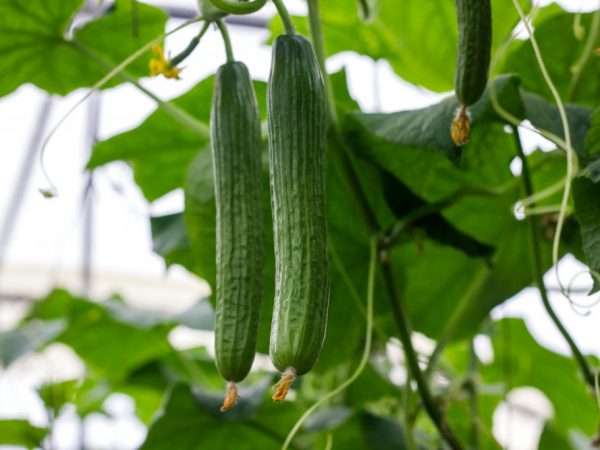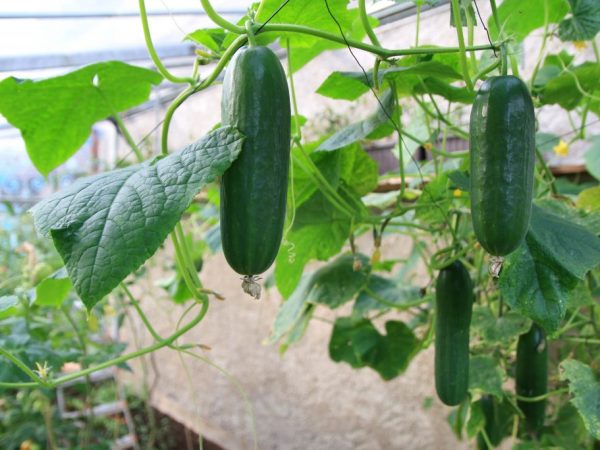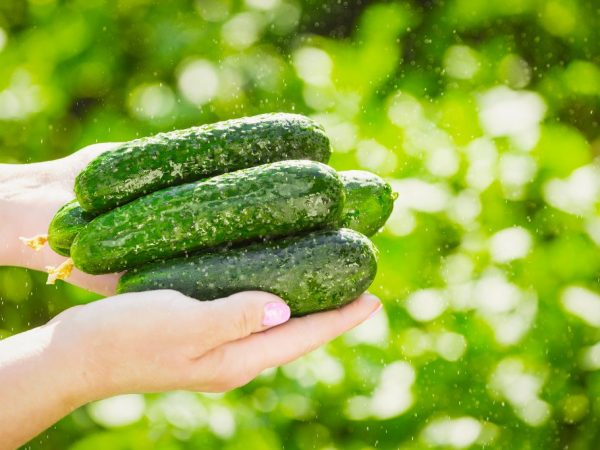Description of the best varieties of cucumbers for greenhouses
How to choose the best greenhouse cucumber varieties? Which ones are worth buying, domestic or imported? These questions are often asked by budding farmers. In this article we will try to tell you in detail about the rules for choosing varieties of cucumbers. We will give brief information about some greenhouse varieties and hybrids. After reading, it will be easier for you to decide which cucumbers to plant in your greenhouse.

Description of the best varieties of cucumbers for greenhouses

Main selection criteria
Indoor varieties are sometimes also called indeterminate. There are many varieties, from which a person's eyes simply run wild.
By purpose of use
The first step is to decide why you will grow cucumbers in a greenhouse.
According to their purpose, all varieties can be conditionally divided into several groups:
- Commodity
- Salad
- Salting
- Exotic.
If you plan to grow cucumbers for sale, then you should choose varieties that tolerate transportation well and retain their presentation for a long time.
Many summer residents build small greenhouses in their gardens in order to quickly get fresh vegetables to the table. In this case, salad varieties are suitable for them, they have light thorns.
If you are going to stock up for the winter, then you need to choose cucumbers suitable for pickling.
You can surprise your neighbors with an exotic variety, which does not even look like a cucumber.
Varieties and hybrids
On sale you can see varietal seeds and hybrids. How do they differ from each other?
Varietal seeds are obtained as a result of long-term selection, selection of the best specimens and crossing of plants of the same species.
Hybrids are the result of interspecies crossing. Very often they do not give birth to offspring, so every year you need to buy new seed. But the yield of hybrids, resistance to diseases and pests, is 30-40% higher than that of varietal cucumbers.
Persistence and type of pollination
When choosing seeds, you need to pay attention to how frost-resistant, shade-tolerant they are.
If you live in Siberia, in the north of Belarus or in the Leningrad region, in the northeast of the Urals, vegetables can freeze even in greenhouses. If the greenhouse is turned to the west or north, there may be shade there most of the day. Therefore, you need to look whether the plant loves a lot of light or not. Another important selection parameter is the method of pollination. Parthenocarpic or self-pollinated cucumber varieties are most suitable for indoor use. And of course, you should pay attention to the ripening time.
Early greenhouse cucumbers

Plants will delight you with an early harvest
For many, growing greenhouse cucumbers is a way to get fresh vegetables in late spring, or even all year round. This is why early and ultra-early varieties are very popular among farmers. They are especially useful in the north, where summers are short and late varieties do not have time to ripen. And in winter, the greenhouse needs heating. The most popular early varieties:
- Goosebump.High-yielding hybrid, parthenocarpic, not susceptible to disease. Cucumber fruits are 8-12 cm long, black thorns, suitable for pickling and souring.
- Dynamite. A high-yield variety, self-pollinated, suitable for salting. Cylindrical bush cucumbers, with brown pimples, up to 14 cm in length.
- Sarovsky. High-yielding, shade-tolerant, frost-resistant, suitable for northern climates. The cucumbers are small, real gherkins.
- Emelya. Hybrid, high yielding and resistant to many diseases. Fruit length - 13-15 cm, universal, it can be salted and eaten in salads in summer. It is also suitable for outdoor use.
- Matilda. Parthenocarpic hybrid with a very high yield. Up to 7 cucumbers can be harvested from one ovary. They have excellent salting qualities, but they can also be eaten fresh.
- Bettina. Another self-pollinated hybrid that bears great fruit in the shade. Early ripening cucumbers are cylindrical, resemble gherkins in shape, grow up to 12 cm in length.
If you want to plant early cucumbers, it is best to choose salad or all-purpose cucumbers. Mid-season and late ones are more suitable for salting. The growing season for early varieties is 40-46 days, for mid-ripening ones - 46-50 days, for late varieties - 51-57 days.
Hybrid varieties
Recently, hybrids are gaining in popularity. According to forecasts, in 2018 they will begin to rapidly displace conventional ones, especially in industrial greenhouses.
Benefits
Hybrids have a number of advantages:
- High resistance to fungal, viral and bacterial plant diseases
- Tolerance to any climate and soil (unpretentious, cold-resistant and shade-tolerant)
- Guaranteed high yield (there is no empty flower)
- Good taste.
Hybrid seeds are grown at special stations. Before being sold, they go through all the processing. You can open the bag and immediately plant them in the ground. Many people say that hybrids are the best option for greenhouses. There are cucumbers of this type for open ground.
Most popular hybrids

Choose the variety that suits you
Here are the most popular and promising modern hybrid varieties:
- Paratunka. The growing season is 40 days, it can grow in any conditions. Early ripening fruits are sweet, without bitterness, with a light edge, best suited for salads.
- Emerald earrings. A hybrid with a high yield, small fruits, up to 11 cm in length, pollinated independently.
- Sugar baby. An early hybrid cucumber with small fruits (up to 7 cm) and large pimples. The pulp is sweet and crispy.
- Nonsense. The ripening time of this variety is average. Fruits are large, up to 14 cm in length, can weigh about 130 g. Gives the best harvest both in the shade and in the light.
- Garland. Highly resistant to various diseases, shade-tolerant. Gherkins are up to 13-14 cm long, with large tubercles on the surface. The cucumbers are early ripening.
- A friendly family. This hybrid is resistant to diseases, unpretentious. It has fruits with medium pimples, white thorns, suitable for salads. Refers to a number of medium-sized.
When buying bush hybrid varieties of cucumbers for a greenhouse, pay attention to imported ones. The Dutch are considered the best. Among them, Ecole, Dolomite, Angelina, Temp are popular. Also, the German hybrid cucumbers Prima Donna and Adam have proven themselves well. The processing of imported seeds is very good, and therefore their germination is high. The Dutch greenhouse varieties are most appreciated. Note that the best performance is given by f1 hybrids, that is, the first generation.
Harvest varieties
Every farmer wants to get the most out of his greenhouse. Therefore, the yield of the variety is one of the main selection criteria. It is especially important for industrial greenhouses. But even an ordinary summer resident should remember that low-yielding, and even medium-yielding varieties in greenhouses do not pay for themselves at all.Here are some yield record holders you should meet:
- Pinocchio. This variety ripens early and does not fight cold weather. With 1 m², you can easily harvest 13 kg of the crop. The fruits are not bitter, they have large pimples.
- Zozulya. An early variety with white-striped fruits that do not turn yellow for a long time. Productivity - 14 kg from 1 m² of greenhouse.
- Summer resident. Another early variety, its yield is 14-5 kg per 1 m².
- Amur. This is a real record holder who tops the yield rating. Up to 30 kg of cucumbers can be harvested from 1 m², which is a super good result.
No matter how productive a variety is, if it is not properly cared for, the result of its cultivation will not be the best. It is recommended to warm up the seeds for a day before planting on a battery or in a thermos with warm water. Be sure to dip the seed in salt water before planting. Seeds that float to the surface should be disposed of. Growing fruitful cucumbers requires the use of growth stimulants. The best option is to use natural ones (nettle infusion, ash, manure). During the growth process, the stems need to be pinched and the stepsons removed so that the planting does not thicken and bear fruit well.
Salting varieties
Many people grow cucumbers to pickle or ferment them for the winter. We have said before that such fruits must have dark thorns. In addition, they should have a firm and crunchy flesh, dense skin. Cucumbers should not grow too large, the ideal length is 7-12 cm. The best varieties of pickled cucumbers for a greenhouse are:
- Adam
- Buran
- Blessed
- Moscow dude
- Mother-in-law
- Legend.
All of these varieties are hybrids, as are the other best greenhouse cucumber varieties. They have high yields and are resistant to many diseases. Their ripening times are average. It is best to take the fruits for salting in the second half of July, when they are ripe enough, but have not yet had time to outgrow.
Exotic cucumbers
If you want to be original, to surprise your neighbors, choose exotic greenhouse cucumbers. They can be completely different from ordinary ones, have a special piquant taste, unusual shape or color. Many are imported from southern countries, therefore they cannot grow in open ground at all, since they are not too cold-resistant. So, here are the most interesting and unusual varieties of cucumbers, which are not included in every catalog:
- Chinese snakes. These cucumbers have long, up to 50-60 cm fruits, twisted like snakes. The taste is pleasant, well suited for salads.
- Chinese miracle. This species is also from long-fruited, grows up to 45 cm, slightly curved. It ripens late, the growing season is about 55 days.
- Lemon cucumber. This species has round, yellow fruits covered with long thorns. It resembles a lemon in appearance.
- Armenian cucumber. It smells like real melon and looks more like a squash than a cucumber.
- Doubtful Tladiant. Cucumbers are oval, bright red, covered with dense thorns.
- Indian momordica cucumber. In appearance it resembles a long green pumpkin, the fruits seem to be covered with warts. This species is considered to be very beneficial to health.
- Melotria rough. Miniature cucumbers, oval in shape, with a rough surface.
- White cucumbers. In this variety, the skin is almost the same color as the flesh, white, with a greenish tinge.
Whatever cucumbers you choose for your greenhouse, carefully study the planting and care methods. The harvest depends not only on the genetics of the plant, but also on the care. It is also worth remembering that even disease and pest resistant hybrids can die if you do not adhere to the elementary growing conditions. Before planting, the soil and greenhouse must be treated with antiseptics, insecticides and cleaned well. To prevent the greenhouse from becoming infected with fungi in winter, it must be well covered from moisture, ventilated from time to time.


